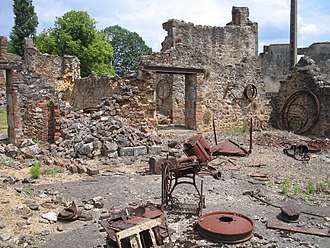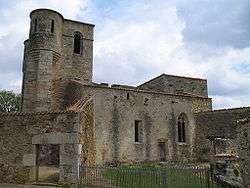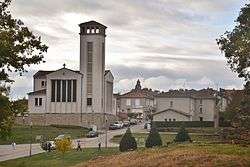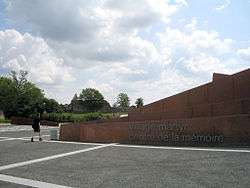Oradour-sur-Glane massacre
On 10 June 1944, the village of Oradour-sur-Glane in Haute-Vienne in Nazi-occupied France was destroyed when 642 of its inhabitants, including non-combatant women and children, were massacred by a German Waffen-SS company.
| Oradour-sur-Glane massacre | |
|---|---|
| Part of World War II | |
 Wrecked hardware – bicycles, sewing machines – left in the ruins of Oradour-sur-Glane | |
| Location | Oradour-sur-Glane, France |
| Date | 10 June 1944 |
| Deaths | 642 killed |
| Victims | French civilians |
| Perpetrators | |

A new village was built nearby after the war, but President Charles de Gaulle ordered the original maintained as a permanent memorial and museum.
Background
In February 1944, the 2nd SS Panzer Division Das Reich was stationed in the Southern French town of Valence-d'Agen,[1] north of Toulouse, waiting to be resupplied with new equipment and fresh troops. Following the Allied Normandy landings in June 1944, the division was ordered north to help stop the Allied advance. One of its units was the 4th SS Panzer Grenadier Regiment ("Der Führer"). Its staff included regimental commander SS-Standartenführer Sylvester Stadler, SS-Sturmbannführer Adolf Diekmann commanding the 1st Battalion and SS-Sturmbannführer Otto Weidinger, Stadler's designated successor who was with the regiment for familiarisation. Command passed to Weidinger on 14 June.[2]
Early on the morning of 10 June 1944, Diekmann informed Weidinger that he had been approached by two members of the Milice, a collaborator paramilitary force of the Vichy Regime. They claimed that a Waffen-SS officer was being held prisoner by the Resistance in Oradour-sur-Vayres, a nearby village. The captured officer was claimed to be SS-Sturmbannführer Helmut Kämpfe, commander of the 2nd SS Panzer Reconnaissance Battalion (also part of the Das Reich division). He may have been captured by the Maquis du Limousin the day before.
Massacre
On 10 June, Diekmann's battalion sealed off Oradour-sur-Glane and ordered everyone within to assemble in the village square to have their identity papers examined. This included six non-residents who happened to be bicycling through the village when the SS unit arrived. The women and children were locked in the church, and the village was looted. The men were led to six barns and sheds, where machine guns were already in place.
According to a survivor's account, the SS men then began shooting, aiming for their legs. When victims were unable to move, the SS men covered them with fuel and set the barns on fire. Only six men managed to escape. One of them was later seen walking down a road and was shot dead. In all, 190 Frenchmen died.
The SS men next proceeded to the church and placed an incendiary device beside it. When it was ignited, women and children tried to escape through the doors and windows, only to be met with machine-gun fire. 247 women and 205 children died in the attack. The only survivor was 47-year-old Marguerite Rouffanche. She escaped through a rear sacristy window, followed by a young woman and child.[3] All three were shot, two of them fatally. Rouffanche crawled to some pea bushes and remained hidden overnight until she was found and rescued the next morning. About twenty villagers had fled Oradour-sur-Glane as soon as the SS unit had appeared. That night, the village was partially razed.
Several days later, the survivors were allowed to bury the 642 dead inhabitants of Oradour-sur-Glane who had been killed in just a few hours. Adolf Diekmann said the atrocity was in retaliation for the partisan activity in nearby Tulle and the kidnapping of an SS commander, Helmut Kämpfe.
Amongst the men of the town killed were three priests who worked in the parish. It was also reported that the SS troops desecrated the church, including deliberately scattering Communion hosts before they forced the women and children into it. The Bishop of Limoges visited the village in the days after the massacre, one of the first public figures to do so, and his account of what he witnessed is one of the earliest available.[4] Amongst those who went to bury the dead and document the event by taking photographs were some local seminarians.
Murphy report
Raymond J. Murphy, a 20-year-old American B-17 navigator shot down over Avord, France in late April 1944, witnessed the aftermath of the massacre.[5] After being hidden by the French Resistance, Murphy was flown to England on 6 August, and in debriefing filled in a questionnaire on 7 August and made several drafts of a formal report.[5] The version finally submitted on 15 August has a handwritten addendum:[6]
About 3 weeks ago, I saw a town within 4 hours bicycle ride up [sic] the Gerbeau farm [of Resistance leader Camille Gerbeau] where some 500 men, women, and children had been murdered by the Germans. I saw one baby who had been crucified.
Murphy's report was made public in 2011 after a Freedom of Information Act request by his grandson, an attorney in the United States Department of Justice National Security Division.[5] It is the only account to mention crucifying a baby.[5] Shane Harris concludes the addendum is a true statement by Murphy and that the town, not named in Murphy's report, is very likely Oradour-sur-Glane.[5]
German response
Protests at Diekmann's unilateral action followed, both from Field Marshal Erwin Rommel, General Gleiniger, German commander in Limoges, as well as the Vichy Government. Even SS-Standartenführer Stadler felt Diekmann had far exceeded his orders and began an investigation. However, Diekmann was killed in action shortly afterwards during the Battle of Normandy; many of the third company, which had conducted the massacre, were also killed in action. The investigation was then suspended.
Postwar trials
On 12 January 1953, a military tribunal in Bordeaux heard the charges against the surviving 65 of the 200 or so SS men who had been involved. Only 21 of them were present, as many were in East Germany, which would not permit their extradition. Seven of those charged were German citizens, but 14 were Alsatians, French nationals whose home region had been annexed by Germany in 1940. All but one of the Alsatians claimed to have been forced to join the Waffen-SS. Such forced conscripts from Alsace and Lorraine called themselves the malgré-nous, meaning "against our will".
On 11 February, 20 defendants were found guilty. Continuing uproar in Alsace (including demands for autonomy) pressed the French parliament to pass an amnesty law for all the malgré-nous on 19 February. The convicted Alsatian former SS men were released shortly afterwards, which caused bitter protests in the Limousin region.
By 1958, all of the German defendants had also been released. General Heinz Lammerding of the Das Reich division, who had given the orders for retaliation against the Resistance, died in 1971, following a successful entrepreneurial career. At the time of the trial, he lived in Düsseldorf, in the former British occupation zone of West Germany, and the French government never obtained his extradition from West Germany.[7]
The last trial of a Waffen-SS member who had been involved took place in 1983. Former SS-Obersturmführer Heinz Barth was tracked down in East Germany. Barth had participated in the Oradour-sur-Glane massacre as a platoon leader in the "Der Führer" regiment, commanding 45 SS men. He was one of several charged with giving orders to shoot 20 men in a garage. Barth was sentenced to life imprisonment by the First Senate of the City Court of Berlin. He was released from prison in the reunified Germany in 1997 and died in August 2007.
On 8 January 2014, Werner Christukat,[8] an 88-year-old former member of the 3rd Company of the 1st Battalion of the "Der Führer" SS regiment was charged, by the state court in Cologne, with 25 charges of murder and hundreds of counts of accessory to murder in connection with the massacre in Oradour-sur-Glane.[9] The suspect, who was identified only as Werner C., had until 31 March 2014 to respond to the charges. If the case went to trial, it could have possibly been held in a juvenile court because the suspect was only 19 at the time it occurred. According to his attorney, Rainer Pohlen, the suspect acknowledged being at the village but denied being involved in any killings.[10] On 9 December 2014, the court dropped the case, citing a lack of any witness statements or reliable documentary evidence able to disprove the suspect's contention that he was not a part of the massacre.[11]

Memorial
After the war, General Charles de Gaulle decided the village should never be rebuilt, but would remain a memorial to the cruelty of the Nazi occupation. The new village of Oradour-sur-Glane (population 2,375 in 2012), northwest of the site of the massacre, was built after the war. The ruins of the original village remain as a memorial to the dead and to represent similar sites and events.
In 1999 French president Jacques Chirac dedicated a memorial museum, the Centre de la mémoire d'Oradour, near the entrance to the Village Martyr ("martyred village"). Its museum includes items recovered from the burned-out buildings: watches stopped at the time their owners were burned alive, glasses melted from the intense heat, and various personal items.
On 6 June 2004, at the commemorative ceremony of the Normandy invasion in Caen, German chancellor Gerhard Schröder pledged that Germany would not forget the Nazi atrocities and specifically mentioned Oradour-sur-Glane.
On 4 September 2013, German president Joachim Gauck and French president François Hollande visited the ghost village of Oradour-sur-Glane. A joint news conference broadcast by the two leaders followed their tour of the site.[12] This was the first time a German president had come to the site of one of the biggest World War II massacres on French soil.[12]
On 28 April 2017, Emmanuel Macron, independent presidential candidate, visited Oradour-sur-Glane and met with the only remaining survivor of the massacre, Robert Hébras.[13]
In popular culture
Television
- The story of Oradour-sur-Glane was featured in the noted 1973–74 British documentary television series The World at War, which was narrated by Laurence Olivier. The first and final episodes (1 and 26, entitled "A New Germany" and "Remember" respectively, show helicopter views of the destroyed village, interspersed with pictures of the victims that appear on their graves.
- The massacre is referenced in the 2010 series World War II in Color in the episode "Overlord", which aired on 7 January 2010. It was also featured in part 2 of Hitler's Death Army, which aired on 27 November 2015, and showed both images from the time along with the ruins as they are today.[14]
Film
- The 1975 French film Le vieux fusil, is based on these facts.[15]
- A feature film, Une Vie avec Oradour, was released in September 2011 in France.[16]
Literature
- In the 1947 Russian novel The Storm by Ilya Ehrenburg, which won the Stalin Prize that year, there is a fictionalized detailed description of the massacre (part vi, chapter a), citing the actual place and the actual SS unit responsible. The novel was published in English in 1948 by the Foreign Languages Publishing House in Moscow, and in 1949 by Gaer Associates of New York.[17]
- In The Hanging Garden (1998) by Ian Rankin, Detective Inspector John Rebus investigates a suspected war criminal accused of leading the massacre of the fictional village of Villefranche d'Albarede, based on Oradour-sur-Glane.[18]
- The poet Gillian Clarke, National Poet for Wales, commemorates the massacre at Oradour-sur-Glane in two poems from her 2009 collection A Recipe for Water,[19] 'Oradour-sur-Glane' and 'Singer'.
- In 2015, Ethan Mordden published One Day in France, a short novel based on the events of 1944. Covering a twenty-four-hour period and moving back and forth between Oradour and nearby Limoges, the story fits invented characters into the historical record.
Gallery
 The main street of Oradour-sur-Glane
The main street of Oradour-sur-Glane The church where the women and children were burned to death
The church where the women and children were burned to death Burned out cars and buildings still litter the remains of the original village
Burned out cars and buildings still litter the remains of the original village
 The new village of Oradour-sur-Glane
The new village of Oradour-sur-Glane The entrance to the memorial museum
The entrance to the memorial museum
See also
|
|
References
Notes
- (in French) « Rubrique Valence d'Agen », Archives du Tarn-et-Garonne, 11 June 2011.
- "Order of Battle for Das Reich as of June 1944". Oradour.info. 9 June 1944. Retrieved 24 November 2012.
- Farmer, Sarah (1999). "Martyred Village". The New York Times (book review).
- Fouché, Jean-Jacques. "ORADOUR, 10 JUIN 1944 : UN MASSACRE NAZI EN FRANCE OCCUPÉE". Violence de masse et Résistance - Réseau de recherche. Retrieved 4 May 2020.
- Harris, Shane (5 June 2014). "The Massacre at Oradour-sur-Glane: An American lawyer finds new evidence about one of World War II's most notorious war crimes, seven decades after D-Day". Foreign Policy.
- Murphy, Raymond J., 2d Lt., U.S.A.C. (1944). "Evasion in France" (PDF). E&E Report No. 866. Archived from the original (PDF) on 18 October 2014.CS1 maint: multiple names: authors list (link)
- Farmer, Sarah. Oradour : arrêt sur mémoire, Paris, Calmann-Lévy, 1994, pp. 30–34
- Smale, Alison (9 December 2014). "German Court Finds Lack of Proof Tying Ex-Soldier to Nazi Massacre". The New York Times. Retrieved 12 December 2014.
- Smale, Alison. "In Germany, Former SS Man, 88, Charged With Wartime Mass Murder". The New York Times. Retrieved 10 January 2014.
- Rising, David (8 January 2014). "88-Year-Old Charged in Nazi-Era Massacre". ABC News. Associated Press. Retrieved 11 January 2014.
- Agence France-Presse (9 December 2014). "Court drops case against German over WWII French village massacre". Retrieved 9 December 2014.
- Olivennes, Hannah. "German president visits site of Nazi massacre in France". France 24 International News. Retrieved 4 September 2013.
- Morenne, Benoit (29 April 2017). "Le Pen Aide Is Fired Over Holocaust Comments". The New York Times.
- "Hitlers Death Army – Das Reich" National Geographic TV website
- "The Old Gun". 22 August 1975 – via www.imdb.com.
- "Une Vie avec Oradour" Allocine
- Search results Bookfinder.com
- Taylor, Andrew (19 January 1998). "Tuesday's Book: The Hanging Garden by Ian Rankin (review)". The Independent. Retrieved 11 May 2016.
- Clarke, Gillian (2009) A Recipe for Water, Carcanet (Manchester), pp. 59–60
Bibliography
- Farmer, Sarah. Martyred Village: Commemorating the 1944 Massacre at Oradour-sur-Glane. University of California Press, 2000.
- Fouché, Jean-Jacques. Massacre At Oradour: France, 1944; Coming To Grips With Terror, Northern Illinois University Press, 2004.
- Penaud, Guy. La "Das Reich" 2e SS Panzer Division (Parcours de la division en France, 560 pp), Éditions de La Lauze/Périgueux. ISBN 2-912032-76-8
Further reading
- Hastings, Max (1982) Das Reich: March of the Second SS Panzer Division Through France Henry Holt & Co. ISBN 0-03-057059-X
- Hastings, Max (1991) Das Reich: Resistance and the March of the Second SS Panzer Division Through France, June 1944 Michael Joseph Ltd. ISBN 0-7181-2074-4
External links
| Wikimedia Commons has media related to Oradour-sur-Glane. |
.svg.png)